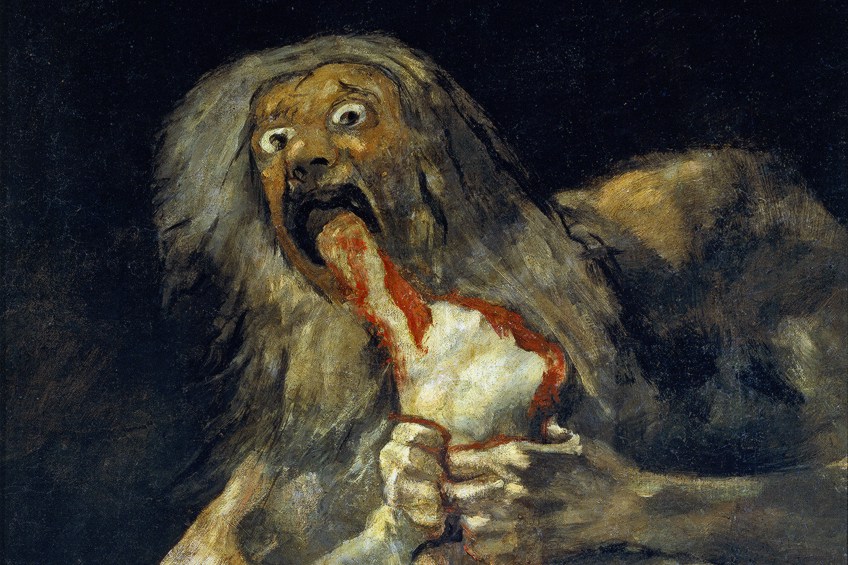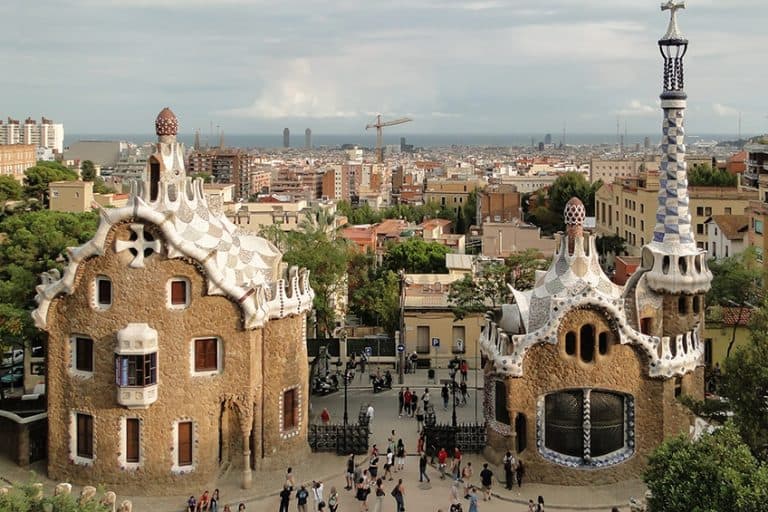“Saturn Devouring One of His Sons” by Francisco Goya – A Study
If you enjoy Greek/Roman mythology, you probably know of the Greek Titan called Kronos, the god of time. You know, the one who ate his own children? This is the subject we will be exploring in the painting Saturn Devouring One of His Sons (c. 1819-1823) by Francisco Goya.
Artist Abstract: Who Was Francisco Goya?
Francisco Goya was born on March 30, 1746, in Fuendetodos, Aragón in Spain, and died in Bordeaux in France. He trained art under several artists, from around 14 years old he was taught by José Luzán, and for several years after, he was briefly taught by Anton Raphael Mengs. He also studied under Francisco Bayeu y Subías.
Goya painted for different patrons, including the Spanish Royal Court.
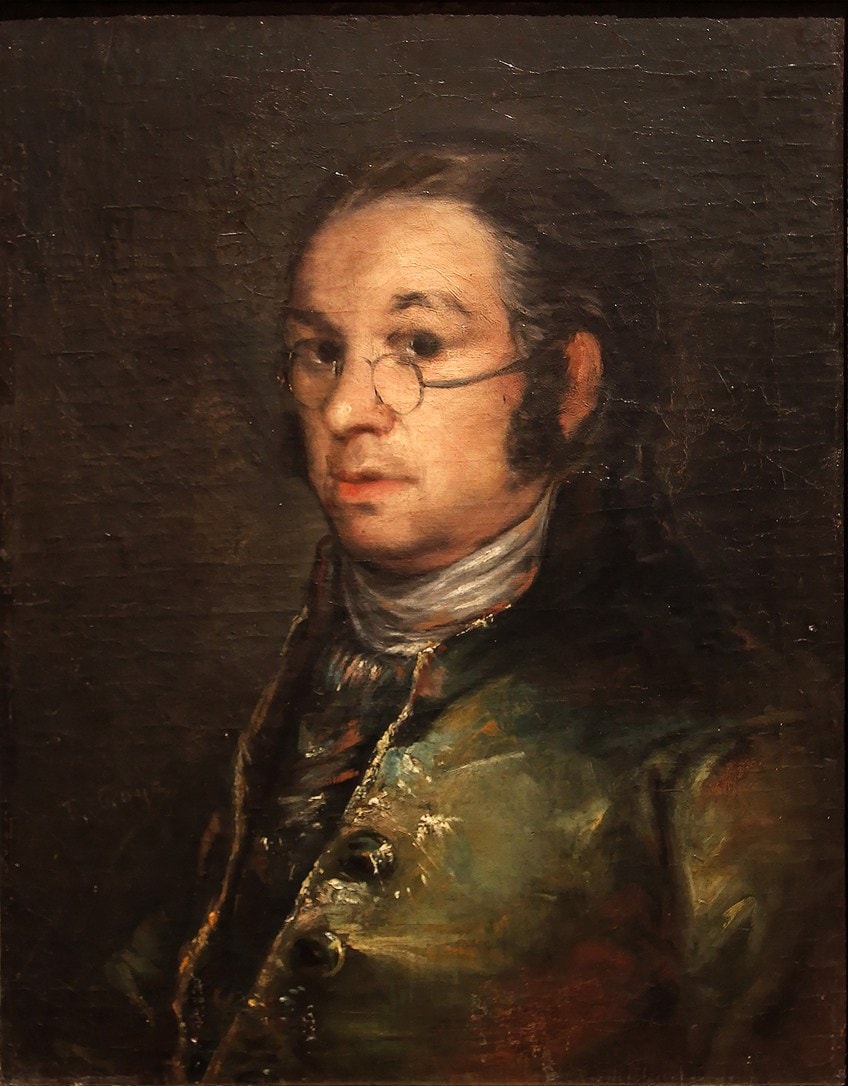
Some of his famous artworks include the oil paintings The Second of May 1808 (1814) and The Third of May 1808 (1814). He was also a printmaker and produced numerous etchings, such as The Sleep of Reason Produces Monsters (c. 1799), which was part of his Los Caprichos (c. 1799) series of aquatint etchings.
Goya touched on various political and social events and influenced modern artists like Édouard Manet, Pablo Picasso, and Surrealist Salvador Dalí.
Saturn Devouring One of His Sons (c. 1819 – 1823) by Francisco Goya in Context
In the article below we discuss the famous Saturn Devouring One of His Sons (c. 1819-1823) by Francisco Goya (it is also sometimes titled Saturn Devouring His Son, and in Spanish, it is Saturno Devorando a uno de sus Niños).
We will start with a brief contextual analysis, providing more background on where and how this painting originated. This will be followed by a formal analysis, discussing the subject matter as well as Francisco Goya’s artistic style in terms of art elements and principles.
| Artist | Francisco Goya |
| Date Painted | c. 1819 – 1823 |
| Medium | Mural (transferred to a canvas) |
| Genre | Mythological painting |
| Period / Movement | Romanticism |
| Dimensions (cm) | 143.5 (H) x 81.4 (W) |
| Series / Versions | Part of Francisco Goya’s Black Paintings |
| Where Is It Housed? | Museo Nacional del Prado, Madrid, Spain |
| What It Is Worth | Donated to the Museo del Prado by Baron Frédéric Émile d’Erlanger |
Contextual Analysis: A Brief Socio-Historical Overview
Francisco Goya was one of the leading Spanish painters from the Romanticism art movement, but he is widely regarded and described as one of the “last old masters” and the “father of Modern art”. He painted within a variety of genres, from portrait paintings of prominent figures from the Spanish Royal Court to war paintings influenced by the Peninsular War from 1808 to 1814.
He was also remembered for exploring more fantastical and grotesque subject matter notably in his “Black Paintings” series, which consisted of 14 murals, done around 1819 to 1823 on the walls in his house, Quinta del Sordo, which was a two-story house located outside of Madrid.
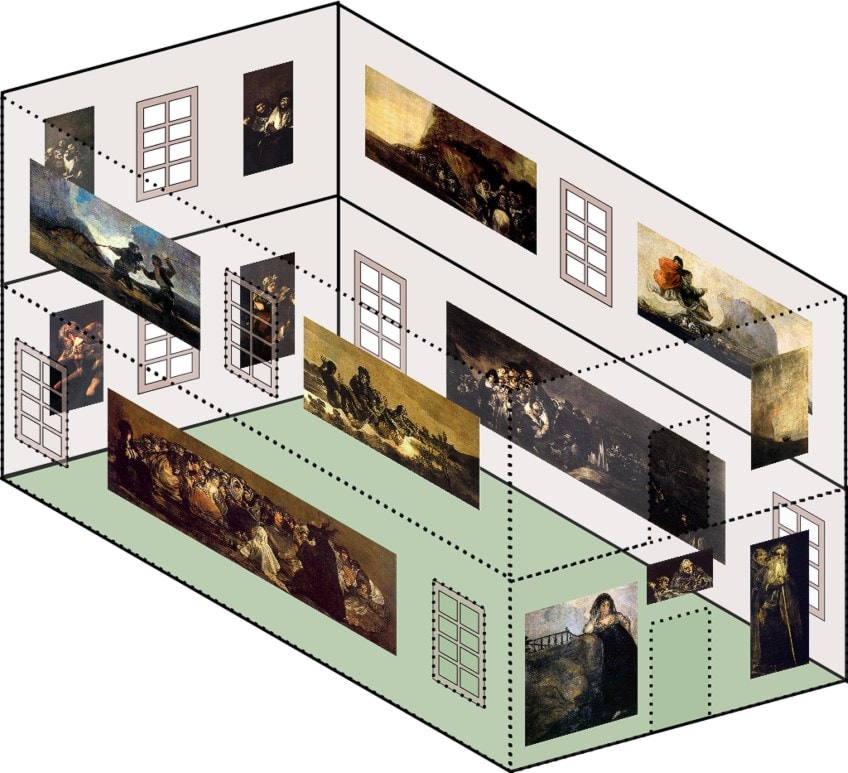
A hypothesis of the arrangement of the Black Paintings (1819-1823) in the Quinta del Sordo, by Francisco de Goya; I, Chabacano, CC BY-SA 3.0, via Wikimedia Commons
Saturn Devouring One of His Sons by Francisco Goya was part of his Black Paintings series, and it was on the ground floor of Quinta del Sordo. The other 13 paintings include:
- The Dog
- Atropos (The Fates)
- Fantastic Vision
- Two Old Men
- Men Reading
- Women Laughing
- Two Old Ones Eating Soup
- Fight with Cudgels
- A Pilgrimage to San Isidro
- Witches’ Sabbath
- La Leocadia
- Judith and Holofernes
- Procession of the Holy Office
The date range is around 1819 to 1823 for all the Black Paintings, additionally, Goya reportedly did not name the paintings; the paintings were possibly titled when they were inventoried by Antonio Brugada in 1828.
However, other art scholars may have titled them throughout the years of their analysis.
In 1874, Baron Frédéric Émile d’Erlanger started the project for the paintings’ removal and placement onto canvas; he bought the house in 1873. The Baron donated the paintings to the Museo del Prado around 1880/1881 after exhibiting them at the Exposition Universelle in Paris in 1878.
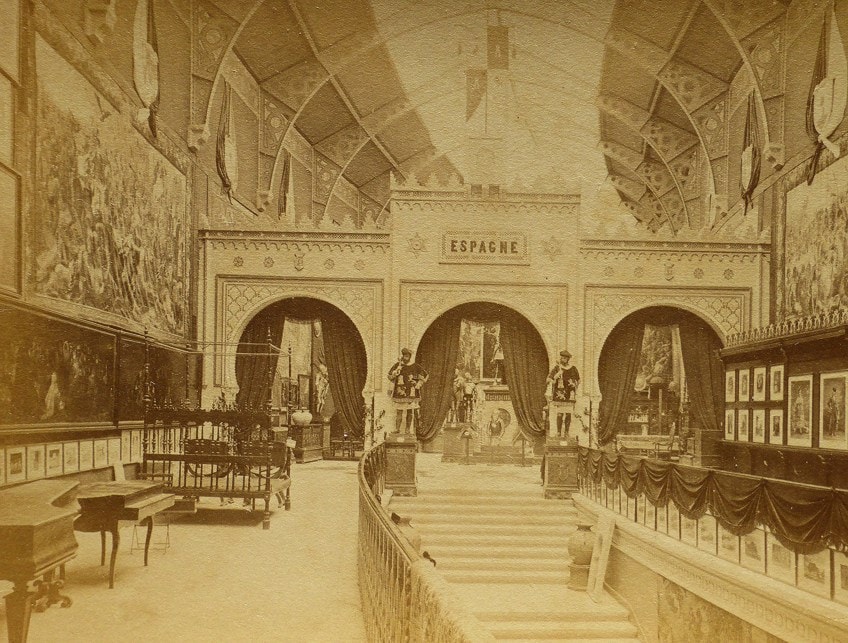
Who Was Saturn?
Before we discuss the painting in more depth, it will be useful to know more about who Saturn was, and to answer the inevitable question of why did Saturn devour his son in the first place? He was the Roman god attributed to the harvest and agriculture.
He was based on the original Greek god Kronos, also known as Cronus, who was a Titan (the king/leader of the Titans, often described as the “Titan King”) as well as the deity of harvests and time.
According to a prophecy, Kronos’ son Zeus was next in line to take his father’s place, and to prevent his downfall he decided to eat his children. Interestingly, Kronos castrated and killed his own father who was Uranus. Kronos’ mother, Gaia, was married to Uranus and wanted to kill him, of which Kronos became the main usurper.
Other Artistic Interpretations
Francisco Goya’s interpretation of Saturn cannibalizing his children was not the only depiction of the Greek myth. We are also reminded of Saturn (c. 1636-1638) by the Baroque painter Peter Paul Rubens. Here, Rubens depicted Saturn as an elderly man holding a long stick in his right hand (our left), which has been described as a “scythe”, one of his symbols. In his left hand (our right) is his infant child, writhing in pain and fear, still alive, as Saturn is in the act of eating him.
Although the subject matter is ghastly and not suitable for sensitive viewers, it nonetheless lacks the outright blatancy and darkness we see in Goya’s portrayal of the scene. It has also been suggested that Goya could have been influenced by Rubens’s painting of the scene.
Additionally, Francisco Goya’s rendition is imbued with the tenets of Romanticism, which sought more expressive and dramatic depictions of subject matter. Artists also explored what they felt, moving away from art that was more calculated and based on reason, notably History paintings during the Neoclassical art period.
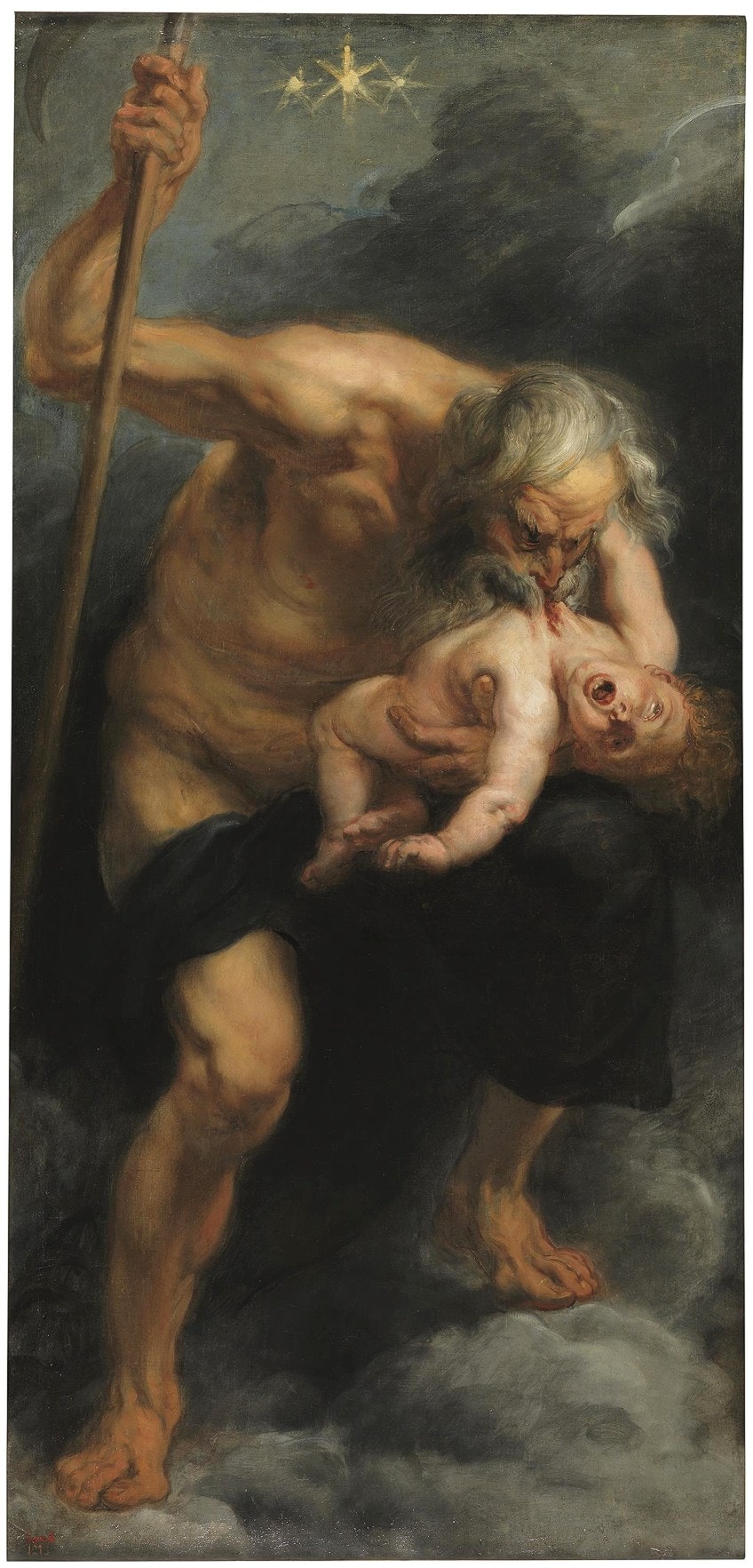
Saturn, Anti-Semitism, and Spain
Saturn, Anti-Semitism, and Spain have one thing in common, and that is Francisco Goya. There are various scholarly interpretations of what could have influenced or inspired Goya to paint Saturn Devouring His Son. However, it is important to note that there has been extensive research done on the meaning of this painting, and there are numerous theories that reach for a rational answer.
Below are several of the more common theories you will come across when reading more about Goya’s Saturn.
Some scholars suggest that Goya could have been influenced by the war between Spain and France during the early 1800s and personifying it through the figure of Saturn as the country devouring its people. Others suggest that maybe Goya was affected by the losses of several of his children, of whom one survived, whose name was Javier Goya. Furthermore, Francisco Goya also became ill while he was living at the Quinta del Sordo and reportedly experienced anxiety and fear of getting old.
Another theory by the art historian Fred Licht is around the false stories about blood libels held by Jewish people who would sacrifice Christian children for their blood and the Jews’ fears around the allegations. This was reportedly something Goya may have come across in Spain because the falsified stories were spread around Europe and possibly caught his attention.
The identity of Goya’s Saturn has also been questioned because the main antagonist is not portrayed with the items or symbols that identify him, such as the scythe, as we have mentioned above in Peter Paul Rubens’ painting. There are also questions raised about why Francisco Goya depicted the child as an adult and not the typical infant from other renditions.
This also ties in with the titles given to the paintings; some scholars suggest that one should avoid trying to liken the paintings with the subject matter too much because we cannot know for sure what Goya’s intention or meaning was for each.
Additionally, it is also suggested that Goya painted the murals for himself and not for public display. It is interesting to note here that Francisco Goya explored the mythological tale several years before his Black Paintings. He made a drawing in red chalk on laid paper of the same title in around 1797 as part of his preparatory drawings for his Los Caprichos series.

Goya depicted an older man in this drawing, assumedly Saturn, and he is in the process of eating one of his sons, chomping down on his left leg while he hangs upside down. In Saturn’s left hand (our right) is another male figure who appears to be hunched over with his head in his hands as if he knows the dreaded death awaiting him.
Interestingly, Goya depicted the two victims as adult men, and not infants, which is echoes the adult figure in his later mural. Additionally, the figure of Saturn appears malevolent in his manner, his eyes are fixed, and he has an unsettling smile or grimace while he eats the figure. Saturn also has the same untidy hair.
Formal Analysis: A Brief Compositional Overview
The formal analysis below will start with a visual description of the Saturn Devouring His Son painting, which will lead onto how Goya composed it in terms of the art elements of color, texture, line, shape, form, and space.
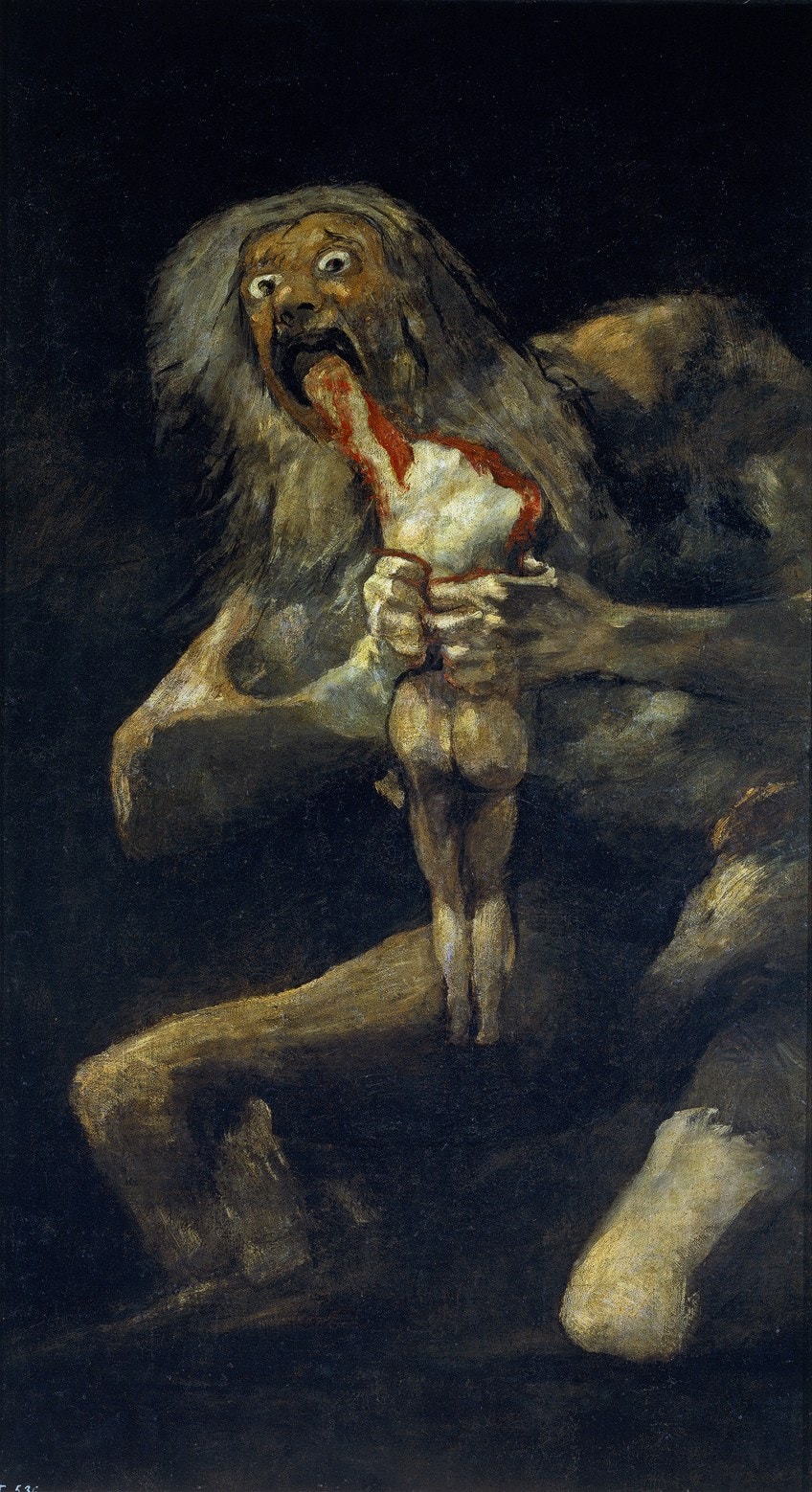
Subject Matter: Visual Description
In Saturn Devouring One of His Sons by Francisco Goya, which has become one of the most recognizable examples of the artist’s Black Paintings, we come face-to-face with a gigantic, spindly, and belligerent figure of Saturn. He is already in the process of “devouring” one of his children, tightly clasping the dead figure in both hands. His mouth is wide open, like a gaping black hole, along with his eyes, which appear almost like two white balls with black orbs in them.
He has often been described as appearing “mad”.

The dead figure, which some art historians believe could be a female, is positioned with its back to us, the viewers, and all we can see are its two legs, buttocks, and upper back.
Additionally, the dead figure appears to be an adult and not a child’s body.
Saturn is about to take another bite from the dead figure’s left arm – he appears to have eaten the hand already. The figure’s right arm and head are also eaten, as suggested by the red patches of blood where those parts used to be.
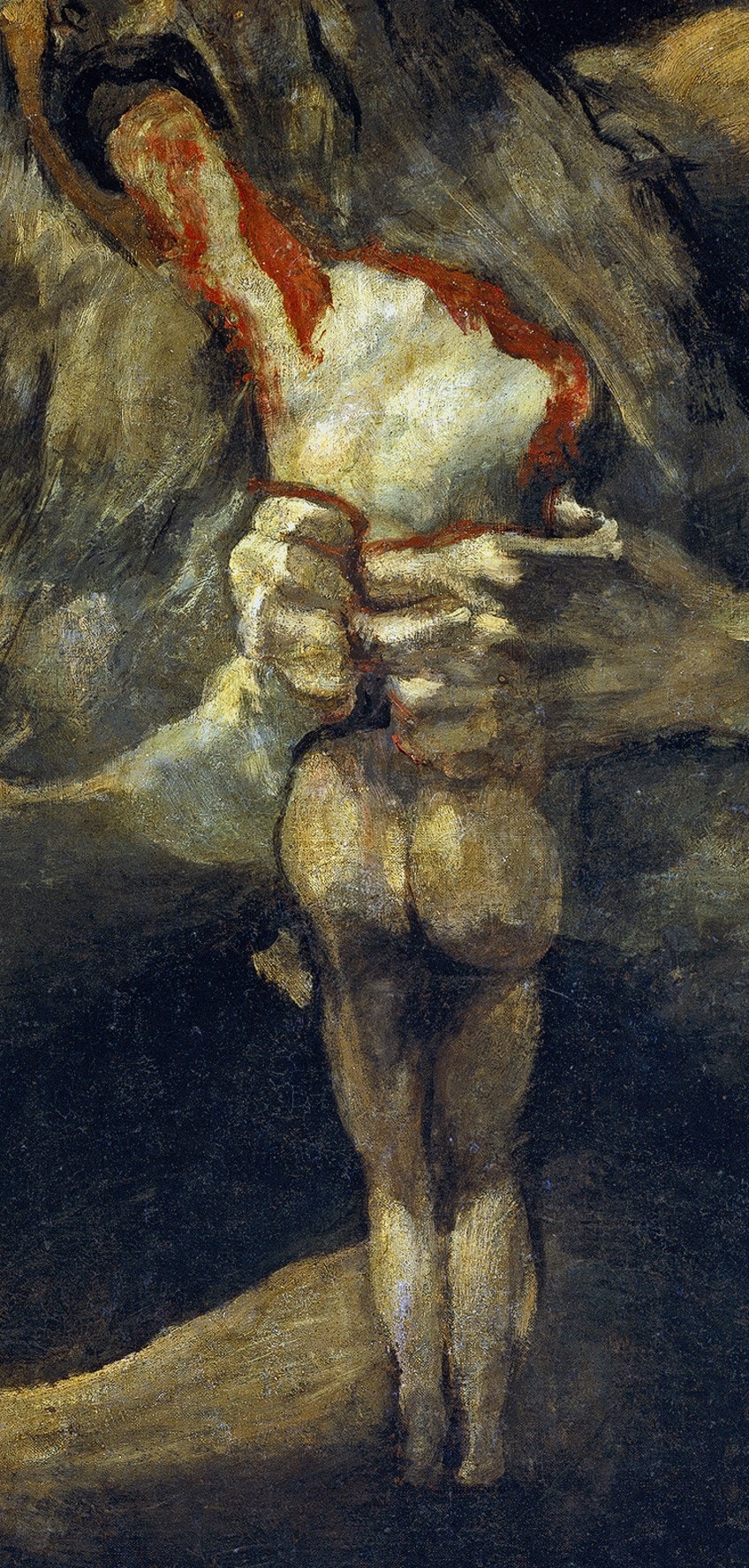
The background is dark and black and has been likened to a cave by some art sources. We are not able to surmise too much about where Saturn is. If we look at his figure more closely, he appears to be half sitting, half standing. His left knee (our right) is rested on the ground while his right leg (our left) is not quite straight, but slightly bent at the knee. He has gray and unkempt hair that falls just over his shoulders, and he is not wearing clothing.
Goya also depicted Saturn’s genitals, which heightens the overall overtness of the scene and what this frightening figure is enacting. Saturn here appears as a wild animal.
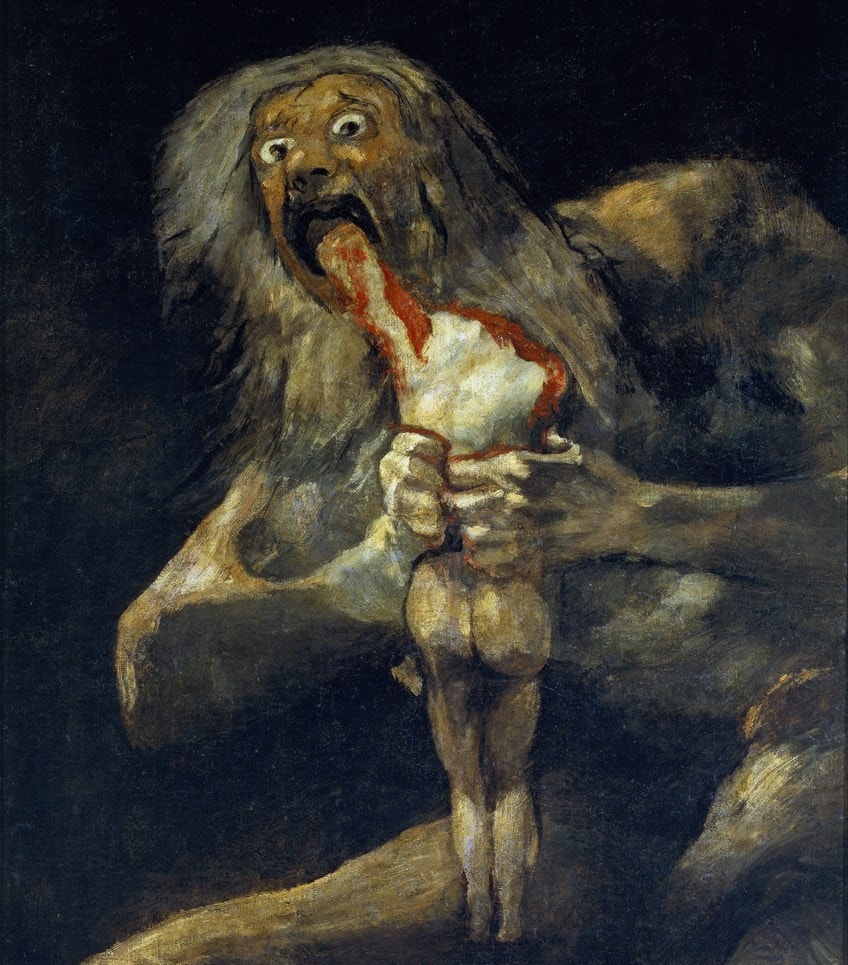
Color
In the Saturn Devouring His Son painting the color palette consists of browns, whites, blacks, and more neutral colors. The red of the blood creates a contrasting effect between the overall neutral hues and emphasizes the subject matter even more.
There are various tones (when a hue is mixed with gray) and tints (when a hue is mixed with white) on Saturn’s skin and legs, which suggest a possible light source. There are also areas of shading, which indicate the contrasts between light and dark areas.
The upper back of the dead figure is also depicted as the lightest area, which, as some suggest, could be for emphasis and leading our, the viewer’s, gaze towards the main focal point. Another point of emphasis is that of the white areas on Saturn’s knuckles, conveying how tightly he is holding onto the dead body, which heightens the feeling of savagery.

Texture
There is a roughened texture in the Saturn Devouring His Son painting, which also creates emphasis on the subject matter. The tactile qualities of the paint are apparent through the brushstrokes, which appear hastily and almost wildly applied, echoing the wild nature of the event taking place.
Line
Line in art can be organic or geometric, and it determines the overall shape and form of the subject matter. Sometimes, compositions can have dark and bold outlines and sometimes the lines blend to create a more naturalistic form, providing the “definition” for the form.
In the “Saturn Devouring His Son” painting, we see more organic lines, which are curvier and seemingly mimic the lines of nature, whether that’s in a figure or a natural object.
For example, the more angular and rounded lines define Saturn’s form, especially at the bends of his knees, and the dead figure in his hands has notably rounded buttocks. Lines can also be diagonal, vertical, or horizontal, and in Goya’s composition, we see numerous diagonal lines created by Saturn’s spindly limbs and a vertical line created by the dead body hanging from Saturn’s grip.
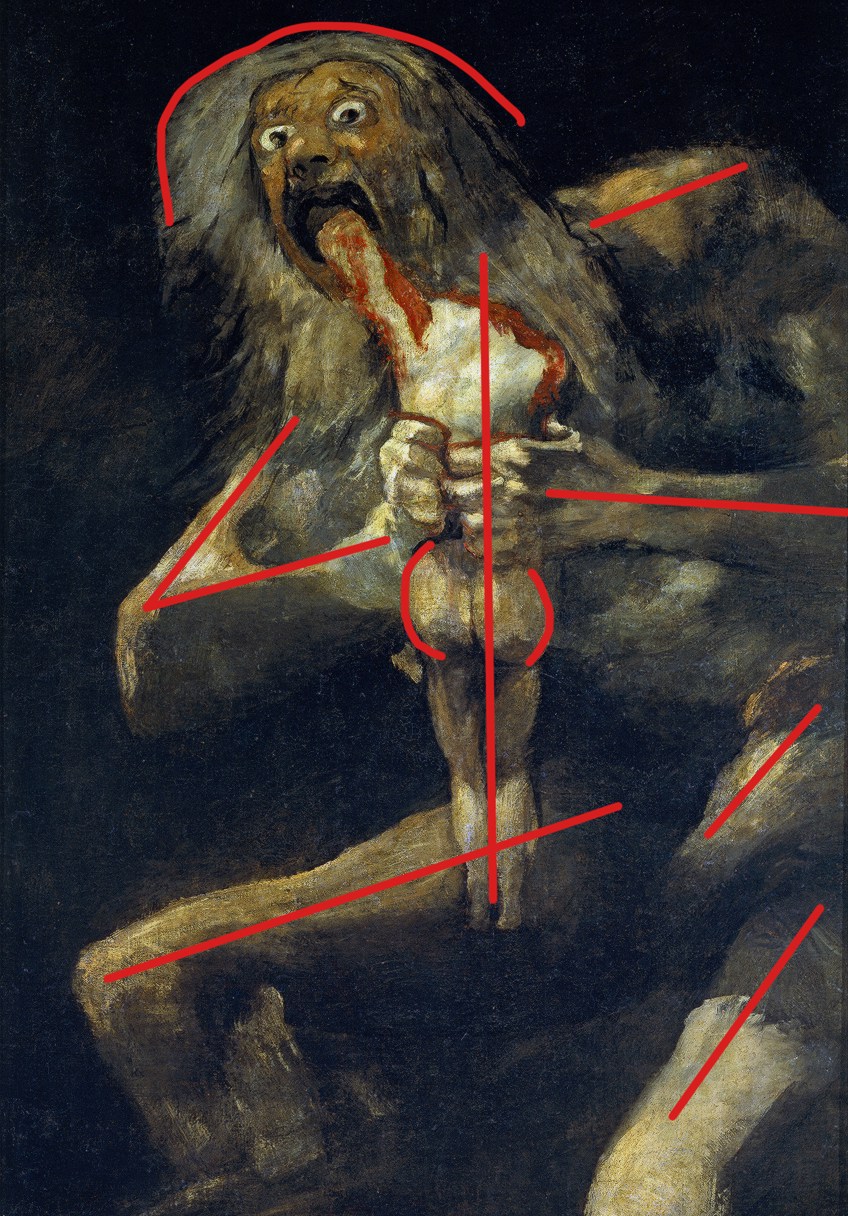
Shape and Form
Just as lines can be organic or geometric, so too can shapes and forms. If we look at the types of shape and form in the Saturn Devouring His Son painting it appears more organic, in other words, closer to nature, compared to geometric, which would be more angular and artificial-looking.
The form of Saturn, although not completely true to nature, nevertheless appears more human-like, including the form of the dead figure.
Space
Space in art can be categorized as positive and negative, the “active area” of the subject itself and the area around it, respectively. In the Saturn Devouring His Son painting, the positive space is undoubtedly Saturn devouring his child and the negative space is the unidentified darkness around him.

Myth to Mural: A Horror Personified
Francisco Goya was an exceptional artist, and significantly influenced the trajectory and trends of the visual arts; his artistic career spanned from the latter half of the 1700s into the early 1800s (he died in 1828). From drawing, and painting, to printmaking, his subject matter was diverse and included commissions for the Spanish Royal Court as well as prints and paintings that addressed the war.
Goya’s series of “Black Paintings” has become part of his wide variety of subject matter and moods. It has been widely researched and debated as to why he painted them. While we may not ultimately know in the end, what we know for sure is that Goya deeply experienced life. What may have decorated the inner walls of his psyche he translated onto the walls of his house, and Goya’s famous “Saturn Devouring His Son” painting, a horror personified, has become a cornerstone of the rawness and complexities of his inner world.
Frequently Asked Questions
Who Painted Saturn Devouring One of His Sons?
The Spanish Francisco Goya painted Saturn Devouring One of His Sons, the so-called Spanish title is Saturno Devorando a uno de sus Niños, during 1819 and 1823, a mural on the walls of his house Quinta del Sordo. He also painted numerous others, all referred to as his Black Paintings.
Where Is the Saturn Devouring His Son Painting?
Saturn Devouring His Son (c. 1819-1823) by Francisco Goya is housed at the Museo Nacional del Prado in Madrid, Spain. Originally the painting was a mural in the artist’s house but was transferred onto canvas, a project that started for all the murals in 1874.
Why Did Saturn Devour His Son?
Based on Greek mythology, Saturn was a Roman god with origins from the Greek god Kronos or Cronus. He devoured his children to prevent a prophecy, that one of his sons would supplant him, from coming true.
What Does Quinta del Sordo Mean?
Quinta del Sordo is the name of the house where the Spanish artist Francisco Goya lived, outside Madrid. The name is translated to the so-called Villa of the Deaf One, which was named after a previous owner, who was deaf.
Alicia du Plessis is a multidisciplinary writer. She completed her Bachelor of Arts degree, majoring in Art History and Classical Civilization, as well as two Honors, namely, in Art History and Education and Development, at the University of KwaZulu-Natal, South Africa. For her main Honors project in Art History, she explored perceptions of the San Bushmen’s identity and the concept of the “Other”. She has also looked at the use of photography in art and how it has been used to portray people’s lives.
Alicia’s other areas of interest in Art History include the process of writing about Art History and how to analyze paintings. Some of her favorite art movements include Impressionism and German Expressionism. She is yet to complete her Masters in Art History (she would like to do this abroad in Europe) having given it some time to first develop more professional experience with the interest to one day lecture it too.
Alicia has been working for artincontext.com since 2021 as an author and art history expert. She has specialized in painting analysis and is covering most of our painting analysis.
Learn more about Alicia du Plessis and the Art in Context Team.
Cite this Article
Alicia, du Plessis, ““Saturn Devouring One of His Sons” by Francisco Goya – A Study.” Art in Context. October 18, 2022. URL: https://artincontext.org/saturn-devouring-one-of-his-sons-by-francisco-goya/
du Plessis, A. (2022, 18 October). “Saturn Devouring One of His Sons” by Francisco Goya – A Study. Art in Context. https://artincontext.org/saturn-devouring-one-of-his-sons-by-francisco-goya/
du Plessis, Alicia. ““Saturn Devouring One of His Sons” by Francisco Goya – A Study.” Art in Context, October 18, 2022. https://artincontext.org/saturn-devouring-one-of-his-sons-by-francisco-goya/.


